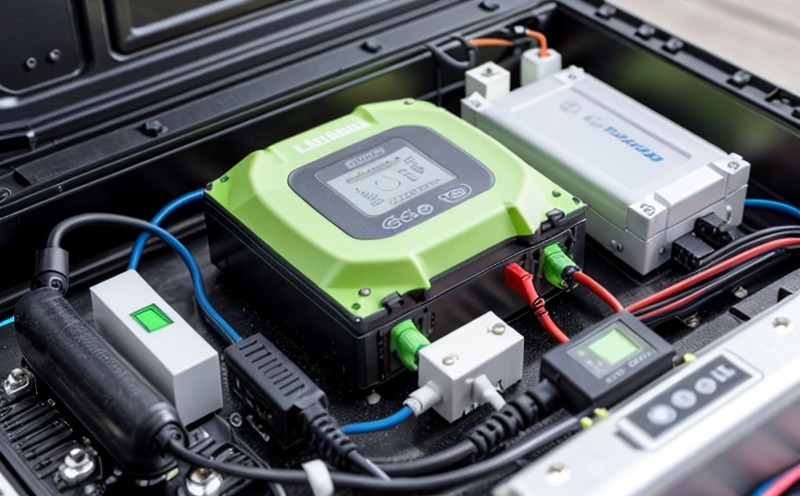IEC 62660-3 Lithium-Ion Cell Electrical and Functional Testing
The IEC 62660-3 standard provides a comprehensive framework for testing lithium-ion cells, which are critical components in portable electronics, electric vehicles, and energy storage systems. This standard is essential for ensuring the safety, performance, and reliability of lithium-ion batteries used in various sectors such as automotive, consumer electronics, and renewable energy.
The test procedures outlined in IEC 62660-3 are designed to evaluate key electrical characteristics including internal resistance, impedance, capacity, voltage, and temperature stability. These tests help manufacturers identify potential weaknesses early in the development process, ensuring that batteries meet the stringent performance requirements set by the standard.
Understanding the importance of these tests is crucial for quality managers and compliance officers who need to ensure their products comply with international standards. For R&D engineers, this service offers a robust platform to innovate while adhering to industry best practices. Procurement teams can leverage IEC 62660-3 to source high-quality batteries that meet the necessary performance criteria.
The testing process involves several critical steps including specimen preparation, initial charging and conditioning, and subsequent electrical characterization under various conditions such as high and low temperatures. This ensures a thorough assessment of the battery's performance across different scenarios it might encounter in real-world applications.
Accurate measurement and analysis are paramount in this process. Instruments used include impedance analyzers, thermal cameras, and advanced data acquisition systems. These tools provide precise readings that form the basis for detailed reports which are essential for quality assurance and continuous improvement.
The results of these tests not only aid in meeting regulatory requirements but also enhance product reliability and customer satisfaction by ensuring consistent performance across all units manufactured. By adhering to IEC 62660-3, manufacturers can build trust with their customers and demonstrate a commitment to producing high-quality products that meet the highest safety standards.
Understanding the intricacies of this testing process is vital for any organization involved in the design, manufacturing, or procurement of lithium-ion batteries. It underscores the importance of rigorous quality control measures throughout the production cycle from raw material selection through final assembly and testing.
- Specimen Preparation: Ensures that each battery cell is identical to others produced under similar conditions.
- Initial Charging: Allows for a stable baseline measurement before any functional tests are conducted.
- Thermal Monitoring: Provides real-time data on temperature changes during various operational states which helps predict potential overheating risks.
- Data Analysis: Utilizes sophisticated software to interpret complex datasets generated by the testing equipment, providing insights into battery health and longevity.
In summary, IEC 62660-3 Lithium-Ion Cell Electrical and Functional Testing plays a pivotal role in safeguarding both consumer safety and business interests. Its rigorous yet practical approach ensures that only reliable products reach the market, thereby fostering confidence among end-users and stakeholders alike.
Why It Matters
The significance of IEC 62660-3 Lithium-Ion Cell Electrical and Functional Testing cannot be overstated. In an era where portable electronics, electric vehicles, and renewable energy systems are rapidly evolving, ensuring the safety and performance of lithium-ion batteries is more critical than ever.
Firstly, consumer safety remains paramount. Lithium-ion batteries have been implicated in several high-profile incidents involving fires and explosions, primarily due to poor manufacturing practices or substandard materials. By adhering to IEC 62660-3, manufacturers can significantly reduce the risk of such accidents by identifying potential flaws early on.
Secondly, compliance with international standards like this one is essential for market access. Many countries require products imported into their markets to comply with specific safety and performance criteria. Meeting these requirements not only opens up new markets but also enhances a company’s reputation as a leader in quality and innovation.
Thirdly, reliability is crucial for the longevity of any product that relies heavily on lithium-ion technology. Consistent test results ensure that each batch of batteries performs consistently over time, extending their useful life span. This consistency translates directly into reduced warranty claims and increased customer satisfaction.
Forth, continuous improvement in design and manufacturing processes comes from thorough testing according to established protocols like IEC 62660-3. Feedback generated during these tests can be used to refine production techniques further enhancing overall product quality.
Lastly, environmental considerations play a role as well since improper disposal of lithium-ion batteries poses hazards to the environment if not managed properly. Through stringent testing that helps avoid such issues at source, companies contribute towards sustainable development goals.
International Acceptance and Recognition
The IEC 62660-3 Lithium-Ion Cell Electrical and Functional Testing is widely recognized across the globe due to its rigorous approach towards ensuring safety, reliability, and performance of lithium-ion cells. Many countries have adopted this standard as a benchmark for their own regulations, thereby fostering global consistency in testing protocols.
By aligning with IEC standards, manufacturers can ensure that their products meet not only local but also international requirements. This harmonization simplifies compliance processes and facilitates smoother trade between different regions.
The widespread adoption of this standard reflects its importance within the industry. It serves as a reference point for all stakeholders involved in the lithium-ion battery ecosystem, from raw material suppliers to final consumers.





